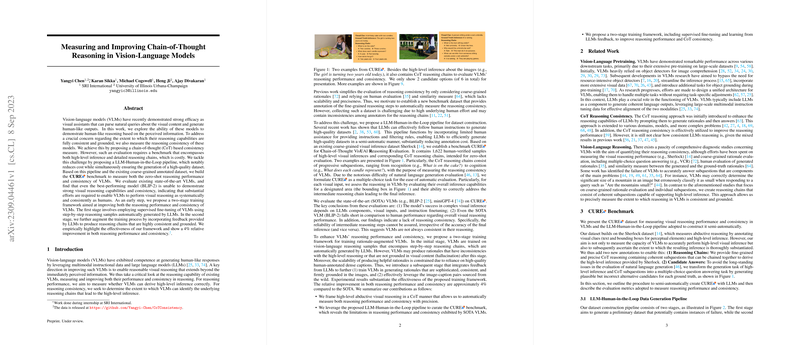Measuring and Improving Chain-of-Thought Reasoning in Vision-LLMs
This paper explores the capabilities and limitations of Vision-LLMs (VLMs) with respect to their reasoning consistency and performance, focusing on their ability to carry out human-like chain-of-thought (CoT) reasoning. The authors acknowledge VLMs' competence in responding to visual queries but underscore the necessity for models to exhibit systematic visual reasoning akin to human cognition. Highlighting discrepancies in reasoning consistency among state-of-the-art VLMs, the paper endeavors to refine both reasoning performance and consistency.
To quantify and enhance VLMs' reasoning capabilities, the paper introduces a benchmark named figs/cure.png, supported by an innovative LLM-Human-in-the-Loop pipeline for dataset creation. This benchmark specifically addresses the dual aim of measuring zero-shot reasoning performance and evaluating reasoning consistency. The authors reveal that even the most proficient VLMs fall short of achieving robust visual reasoning consistency, emphasizing a persistent gap when juxtaposed with human levels of inference accuracy.
The paper proposes a two-stage training framework to ameliorate this gap. The framework encompasses supervised fine-tuning followed by learning from feedback, devoid of human annotations. This approach aims to engender reasoning chains that are consistent, well-grounded, and enhance overall visual reasoning. The framework purportedly yields a relative improvement of 4% in reasoning performance and consistency, signifying a tangible advancement in VLM training methodologies.
From an empirical perspective, the paper evaluates current VLMs using figs/cure.png, comprising questions designed to gauge both overall reasoning and the quality of intermediate reasoning processes. Results indicate a reliance on the integration of LLMs and multimodal data to achieve significant inference performance. However, challenges remain, given that substantial room for improvement persists.
This research has profound implications for the development of VLMs. Enhancing reasoning consistency is crucial not only for improving existing models but also for guiding future advances in AI and multimodal learning. The findings suggest directions for future work, such as the integration of more comprehensive visual data sources and further refinement of the training procedures leveraging scalable datasets.
In conclusion, the paper makes a substantive contribution to the field of vision-LLMing by highlighting current limitations, proposing concrete methods for improvement, and offering a substantial dataset and benchmark for future exploration of visual reasoning in AI. The proposed framework, along with the figs/cure.png benchmark, lays a foundational groundwork for further investigations into the reasoning abilities of VLMs and their potential to more closely replicate human-like understanding.
This research trajectory might see future developments encompassing more robust models, capable of seamlessly integrating multimodal information to achieve a level of reasoning and consistency that closely mirrors that of human cognition, potentially revolutionizing the interface between humans and AI systems.
